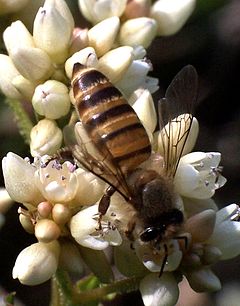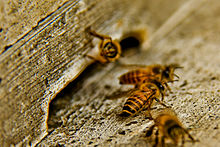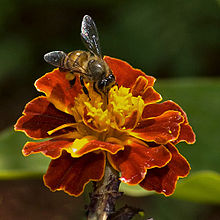- Apis cerana
-
Eastern honey bee 
Scientific classification Kingdom: Animalia Phylum: Arthropoda Class: Insecta Order: Hymenoptera Suborder: Apocrita Family: Apidae Subfamily: Apinae Genus: Apis Subgenus: (Apis) Species: A. cerana Binomial name Apis cerana
Fabricius, 1793Apis cerana, or the Asiatic honey bee (or the Eastern honey bee), is a species of honey bee found in southern and southeastern Asia, such as China, India, Japan, Malaysia, Nepal, Bangladesh and Papua New Guinea. This species is the sister species of Apis koschevnikovi, and both are in the same subgenus as the Western (European) honey bee, Apis mellifera. [1] [2] [3] [4]
Contents
Subspecies
(following Engel, 1999).
- Apis cerana cerana Fabricius ( = "sinensis") - Afghanistan, Pakistan, north India, China and north Vietnam
- Apis cerana heimifeng Engel
- Apis cerana indica - Fabricius South India, Sri Lanka, Bangladesh, Burma, Malaysia, Indonesia and the Philippines
- Apis cerana japonica Fabricius - Japan
- Apis cerana javana Enderlein
- Apis cerana johni Skorikov
- Apis cerana nuluensis Tingek, Koeniger and Koeniger
- Apis cerana skorikovi Engel ( = "himalaya") - Central and east Himalayan mountains (Ruttner, 1987)
There are eight subspecies of A. cerana are currently recognized out of eight two of subspecies are predominant and used for Apiculture in India are: Apis cerana cerana and Apis cerana indica, these species are similar to Apis mellifera except in color A. cerana indica is black stripes on their abdomen and they live close to hilly areas and are sometimes seen in plain regions, A. cerana cerana has yellow stripes on their abdomen and habituated to plain regions of India, and A. mellifera tends to be slightly larger than A. cerana and can be readily distinguished from A. mellifera. These are less aggressive and also less swarming behavior than any other wild bees such as Apis dorsata and Apis florea and can be easily used for beekeeping.[citation needed]
Behavior
In the wild, A. cerana prefer to nest in small spaces, such as hollowed out tree trunks. Like the Western honey bee, they are sometimes domesticated and used in apiculture, mostly in wooden boxes with fixed frames. Their size is similar or somewhat smaller than Apis mellifera, and they also have a more prominent abdominal stripes. Their honey yield is smaller, because they form smaller colonies. In folk medicine, their beeswax is used to treat and heal wounds. These bees can be adapted to living in cavities in some human structures and in purpose-made hives, and their nesting habit means that they can potentially colonize temperate or mountain areas with prolonged winters or cold temperatures. [citation needed]
Absconding behavior
Apart from reproductive swarming A. cerana have migration and absconding behavior which means that these species abandon the current nest and move towards new location where there is abundant nectar and pollen supply available and again build new nest. These bees usually don’t store great amounts of honey. This means that they are more vulnerable to starvation if there is a prolonged shortage of nectar and pollen. Absconding will start when there is not enough pollen and nectar. After the last brood emergence, the adult bees fill their honey stomachs from the storage, and swarm off eventually to establish a new nest at a new location. A. cerana has more absconding behavior than A. mellifera.
Nest Defense
A. cerana are more inclined to retreat inside than to attack an intruder passing near their nest. But any attempt to open the nest, especially if it is done roughly, will cause bees to fly out and sting the intruder.
Nest Thermoregulation
A. cerana maintains internal hive temperatures with a precision similar to that of A. mellifera, using similar mechanisms. A. cerana colonies maintain their brood temperature in the range of 33-35.5 degree Celsius even while ambient temperatures vary between 12 and 36 °C. This mechanism clearly shows that they possess effective nest thermoregulation systems. During summer A. cerana employs evaporative cooling, where the worker bees cluster outside the nest in hot weather and fan their wings, thus removing excess heat and moisture from the nest and decreasing the hive temperature.
- Thermal defense: When an Apis cerana hive is invaded by the Japanese giant hornet (Vespa mandarinia), about 500 Japanese honey bees (A. cerana japonica) surround the hornet and vibrate their flight muscles until the temperature is raised to 47 °C (117 °F), heating the hornet to death, but keeping the temperature still under their own lethal limit (48-50 °C). European honey bees (A. mellifera) lack this behavior. [5]
Communication
A. cerana communicate with their nest members about the presence and location of food and water sources by means of waggle dance and round dance languages. The waggle and round dances of A. cerana are performed in the dark, on a vertical comb surface of a multicomb nest, so they usually convey their wagging motions in the dark via vibrations. They have a foraging range of about 1 Km. Most of their biology is similar to A. mellifera with very slight difference in dance language, cell size in the comb and honey production. As A. mellifera produces more honey and has bigger cell size in their combs and very slightly long dancing cycle than A. cerana.
Reproductive Swarming
In A. cerana reproductive swarming is similar to A. mellifera, for example, A. cerana reproductive swarms settle at 20-30 meter away from the natal nest (natal nest means mother or primary colony), stay for a few days and then depart for a new nest site, after getting information from the nest locating scout bees. Scout bees begin searching for suitable cavities in which to construct the swarm’s home. Successful scouts come back and report the location of suitable nesting site to other bees by performing communication dances on the surface of the swarm cluster in the same way they would do for food sources.
Worker sterility and Queen Signaling
Honeybee Workers are infertile females and possibility of their reproduction is extremely limited. Their fertility is controlled by queen signals. The Queen honeybee informs workers of her presence by pheromones that queens secrete from their mandibular glands. These signals are acquired by workers in close vicinity of the queen and then spread to other works in the colony mainly by body contacts. In presence of queen pheromone signals, the vast majority of workers refrain from activating their ovaries. In the absence of queen bee at least 5% of the worker bees activate their ovaries and start laying eggs, this leads to multiple eggs in one cell.
Pests
Apis cerana is the natural host to the mite Varroa jacobsoni and the parasite Nosema ceranae, both serious pests of the Western honey bee.[6] Having coevolved with these parasites, A. cerana exhibits more careful grooming than A. mellifera, and thus has an effective defense mechanism against Varroa that keeps the mite from devastating colonies. Other than defensive behaviors such as these, much of their behavior and biology (at least in the wild) is very similar to that of A. mellifera.
References
- ^ BIODIVERSITY OF HONEYBEES, M.R.Srinivasan, Department of Agricultural Entomology - Tamil Nadu Agricultural University accessed Jul 2010
- ^ Engel, M.S. (1999) The taxonomy of recent and fossil honey bees (Hymenoptera: Apidae: Apis). Journal of Hymenoptera Research 8: pgs.165-196.
- ^ Photos of Apis cerana
- ^ Benjamin P.Oldroyd and Siriwat Wongsiri: Asian Honey Bees (Biology, Conservation, and Human Interactions). 2006: Harvard University Press, Cambridge, Massachusetts and London, England.
- ^ Apis cerana' "cooking" a hornet to death video
- ^ Ritter, Wolfgang Nosema ceranae Albert Ludwigs University of Freiburg
Categories:- Apis (genus)
- Beekeeping
Wikimedia Foundation. 2010.


